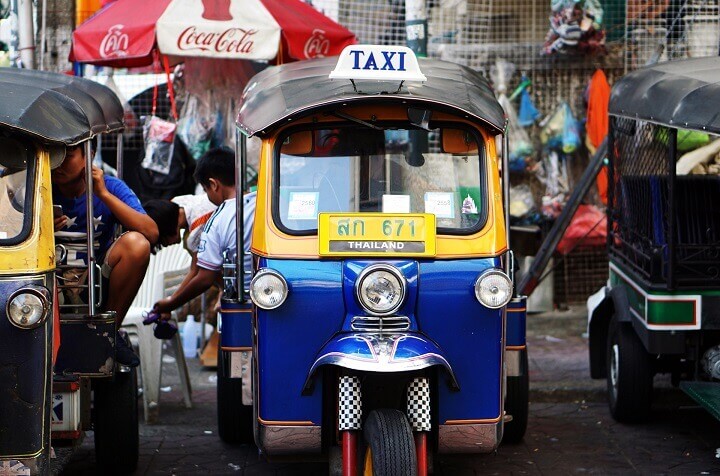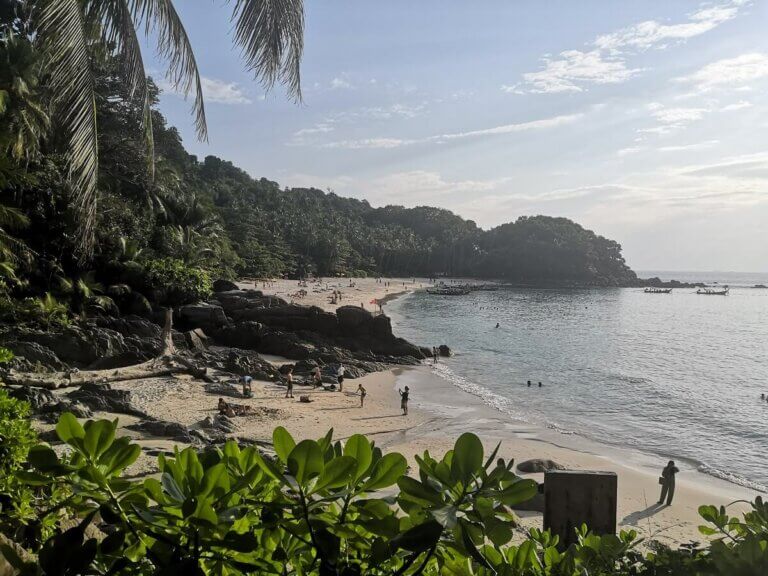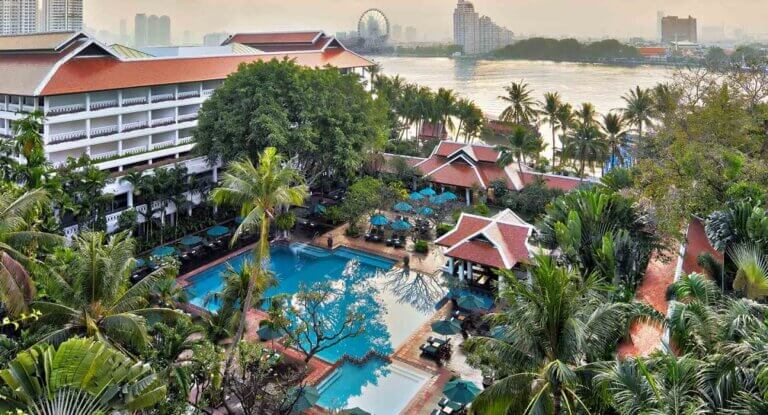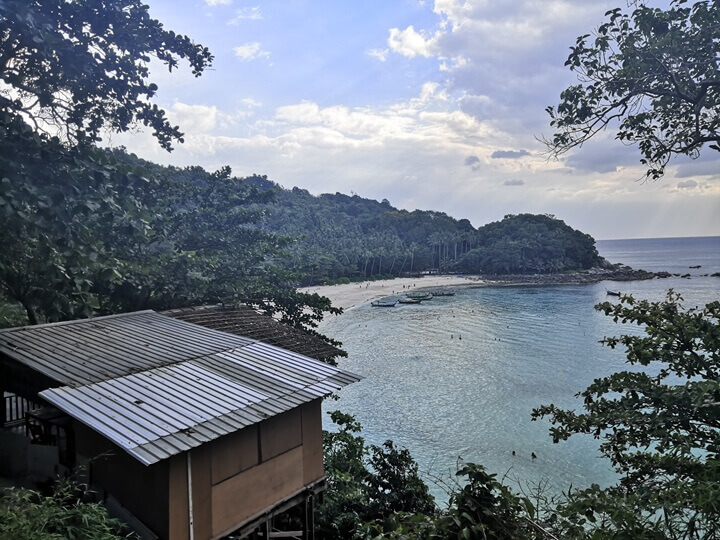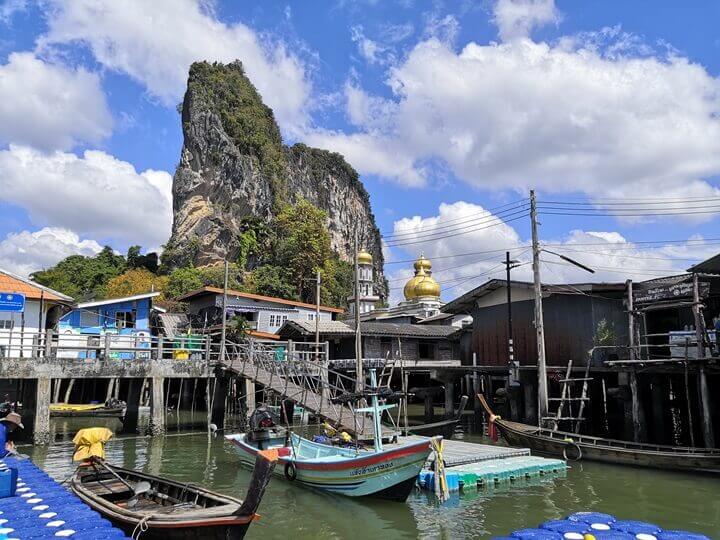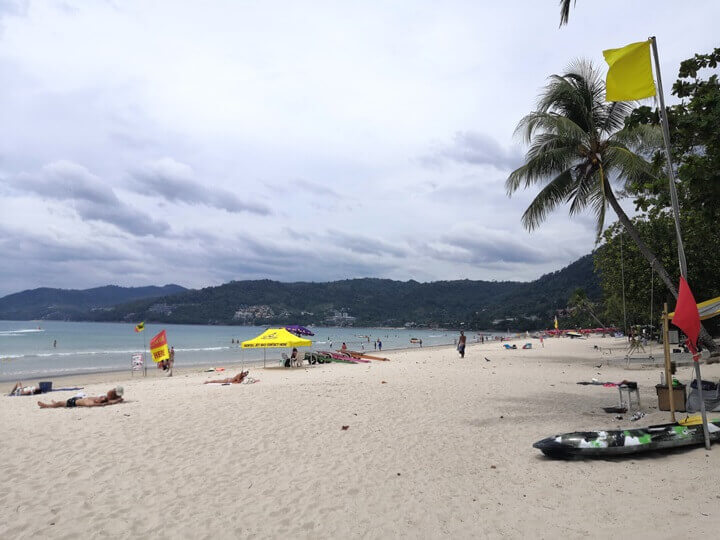Is There Uber in Thailand in 2024? Everything You Need to Know
Wondering if there’s Uber in Thailand? Read on to find out.
The short answer is no, there is currently no Uber in Thailand. However, you can use a ride-hailing app called Grab instead. Other ride-hailing apps that are available in Thailand are Bolt and InDrive.
These apps work in a similar way to Uber and are affordable and easy to use. However, they do have some unique features that this guide will touch on in more detail.
Alternatively, you can use regular taxis, tuk-tuks and public transport to get around. If you are heading to Bangkok, you will also have access to some additional transport options.
After spending several weeks in Thailand, I can safely say that even without Uber getting around the country is relatively easy as a tourist.
Let’s take a closer look at the main alternative to Uber in Thailand as well as other transport options to help you prepare for your next trip.
Disclosure: Some of the links below are affiliate links, which means that at no additional cost to you, I may earn a small commission if you click through and make a purchase. Please note, I only recommend products and services that I know and love. Read full Privacy Policy here.
Is There Uber in Thailand?
Uber operated in Thailand until 2018. It was then taken over by Grab, a multinational tech company headquartered in Singapore.
Grab is the most significant player in ridesharing and food delivery not just in Thailand, but also in Southeast Asia. It operates in Singapore, Indonesia, Vietnam, Myanmar, Malaysia, Cambodia and the Philippines.
So, although it might be tempting to reach for the familiar Uber icon when you’re in Thailand, you may need to use Grab instead.
However, other ride-sharing apps, such as Bolt and InDrive, can also be used as an alternative to Uber or Grab in some parts of Thailand.
Main Uber Alternative in Thailand: Grab App
As we’ve established, the main alternative to Uber in Thailand is the Grab app. It works pretty much in the same way as Uber, so there’s not going to be much of a learning curve when you start using it in Thailand.
Grab is a convenient, easy to use and affordable way to get around major cities and towns in Thailand. You simply need to download the app, select your destination and wait for the driver to arrive. There are usually no issues with getting a Grab car in an area where the app operates.
Another great thing about Grab is that you will know how much you will pay for your trip in advance. In contrast, if you are using a regular taxi in Thailand drivers often try to overcharge you. They request a flat fare and refuse to put the meter on. Grab removed the need to deal with these annoying situations.
There are multiple Grab ride options for you to choose from. You can opt for a metered taxi via GrabTaxi or a private car via GrabCar.
Alternatively, if you just want to get in a car as quickly as possible, you can select JustGrab to get the closest taxi or car available. The cheapest option is usually GrabBike, which involves travel by motorcycle.
For a more high-end experience, opt for GrabCar Premium or GrabExec to travel in a luxury car. There is also GrabAssist with its accessibility features and GrabPet that offers rides with specialised pet seat covers.
Grab also goes much further than just rides. It also offers food, grocery, document and parcel delivery services.
How to Use Grab in Thailand
Getting a ride through Grab is very similar to getting one through Uber.
First, download the app and create your account by using your phone number. You can purchase a Thai SIM Card on arrival to use the app with a local number. It will work with your home mobile number as well.
If you prefer cashless payments, add your credit or debit card details before ordering a ride. There’s an option to pay via Paypal as well.
Once you’re ready to order a ride, open the app and enter your destination. You can order a ride immediately or schedule one for later. Then confirm your pickup location and select your preferred service (e.g., GrabTaxi or JustGrab).
You will then be able to see a list of available taxis or private cars along with the ride price and the time it takes for the driver to reach you. If you’re happy with the options, select a car and book your ride.
That’s it, you’re ready for your trip.
How to Pay for Grab in Thailand
Grab accepts cashless payments via debit and credit cards as well as GrabPay. You can link your card directly through the app. Keep in mind that if you are using your home country bank for Grab payments, you may have to pay foreign currency conversion fees.
You can also pay with cash on arrival at your destination, just like you would in a regular taxi. You may prefer this option if you’d rather not share your bank details with the Grab app.
Just like Uber, Grab also lets you add a tip after your journey if you’d like to reward your driver for a good experience.
How Much Does a Grab Ride Cost in Thailand
The price of a grab ride in Thailand depends on the distance you travel, location, type of service and demand. Obviously, the longer the journey the higher the cost.
Also, you may find that getting a Grab ride in a big city like Bangkok is generally cheaper than in a more remote location. A high-end ride through GrabPremium will lead to a more expensive ride as well.
In general, rush hour rides are more expensive due to surge pricing. This comes into effect when there are more ride requests than cars available on the road. Rides can cost up to 30% more as a result.
For example, a 10-kilometer ride in Bangkok would cost you 300 baht (US $9) with GrabCar, 380 baht (US $11) with GrabTaxi and only 100 baht (US $3) by GrabBike.
Keep in mind that if you choose Grab to travel from a Bangkok airport into the city centre you will also need to pay the road toll. It won’t be included in the original price reported in the app.
You can let the driver pay when you’re going through the toll area and then charge you later. The Highway toll from Suvarnabhumi Airport (BKK) to Bangkok is 75 Baht (US $2) and 115 baht (US $3) from Don Mueang Airport (DMK).
Is Grab Reliable in Thailand
Yes, Grab offers a reliable service. It is normally easy and quick to get a driver after making a request through the app. As the price is determined before you get in the car, you won’t normally have any issues with fare negotiation.
If you’ve taken a regular taxi in Thailand before, you probably know that sometimes taxi drivers may refuse to take you to your destination. This is either due to language barrier or simply not wanting to travel there. You are not going to experience this with Grab.
Is Grab Safe in Thailand
Grab is also generally safe to use. The rides are GPS tracked and you can share your journey details with your contacts if needed.
There is also the option of reporting any unprofessional or unsafe behaviour directly through an emergency button in the app. Grab normally responds quickly to any issues raised.
Nevertheless, no matter where you are in the world, the usual precautions should apply:
- Check the car make and the number plates before you get in the car
- If something feels off, don’t get in the car
- Be always aware of your surroundings so if something does go wrong, you can quickly request Emergency Assistance from Grab and dial 191
- Keep your personal belongings close and don’t flash any valuables to avoid attracting unwanted attention
- Sit behind the front passenger seat – this is both for your and your driver’s sense of safety
In addition, app users can request a female driver with the GrabCar (Lady) option at no extra cost.
Where Is Grab Available in Thailand
Grab is available in major cities such as Bangkok and Chiang Mai. You can also use Grab in popular tourist destinations such as Phuket, Pattaya, Hua Hin and Krabi.
If you are staying in a more remote location, you will need to use local public transport options.
Here’s the most up-to-date list of Grab locations in Thailand:
- Ayutthaya
- Bangkok
- Buriram
- Chiang Mai
- Chiang Rai
- Hua Hin
- Khon Kaen
- Krabi
- Nakhon Ratchasima (Korat)
- Nakhon Si Thammarat
- Pattaya
- Phuket
- Songkhla & Hat Yai
- Surat Thani & Koh Samui
- Ubon Ratchathani
- Udon Thani
Other Ride-Hailing Apps in Thailand: Bolt and InDrive
Ridesharing is a highly competitive business in Southeast Asia. Although Grab remains the biggest ride-hailing apps in the country with the most cars and the largest geographic coverage, it is not the only app you can use while exploring Thailand.
Here are a couple of alternative ride-hailing apps you can use alongside Grab. They all work in a similar way to Uber and Grab, so you can easily test out a couple during your stay in Thailand.
Bolt
Bolt is probably the second most popular ride-hailing app after Grab. Just like other ride-hailing apps, Bolt offers a range of rides including economy cars, comfort rides, regular taxis, XL cars for large groups, and scooters in Chiang Mai.
In general, Bolt ends up being slightly cheaper than Grab. However, one big difference between the two is that Bolt users can only pay in cash directly to the driver, while Grab offers cashless payments.
It’s worth noting that Bolt has a more limited geographic coverage than Grab. The app is currently available in Bangkok, Chiang Mai, Phuket and Pattaya. Bolt also offers airport transfers to and from the airports in these locations.
Similar to other ride-hailing apps, Bolt’s safety features include the emergency assist button with the support team available 24/7 and the option to share your live location and driver details with your friends and family.
Drivers are vetted, and Bolt imposes a limit on the hours they can drive to make sure they are sufficiently alert to do the job. You can also rate your driver.
Bolt is generally reliable, but keep in mind that fewer drivers use it compared to Grab. You may find that during rush hour it can be challenging to secure a ride. Interestingly, you may find that some drivers work with both Grab and Bolt to maximise their earnings.
InDrive
InDrive is another ride-sharing app which is on the rise across the world. Currently available in Phuket, Pattaya, Koh Samui and Krabi, the app has a unique business model that makes it stand out from the competitors.
InDrive allows you to negotiate your ride fare before accepting a ride. When you request a trip, you will receive offers from different drivers. You can choose the one that you prefer or negotiate your price further.
Negotiation can add some extra time to the whole process of getting a ride, but you may be able to get a better price that what you would get on other apps. In addition to pricing, you can also select your driver based on their rating, car model and arrival time.
InDrive only does cash payments that need to go directly to your driver. Interestingly, InDrive takes a significantly lower fee from drivers than other apps do, making it a more attractive proposition for them.
InDrive has similar safety features to other ride-hailing apps including the ability to share your live location with your contacts and an emergency assistance button.
The app is generally reliable, but compared to Grab and Bolt, fewer drivers use it, so it can sometimes take longer to get a ride. However, with lower driver fees, I wouldn’t be surprised if more drivers will join the app soon.
Can You Use Grab or Bolt or InDrive at Airports in Thailand?
Yes, it is possible to use ride-hailing apps such as Grab, Bolt, or InDrive to get from an airport in Thailand to your destination. They are not allowed to use the pickup points for official metered taxis. Normally, you will receive instructions on where the driver will pick you up through the app.
Nevertheless, in April 2024, Grab opened its first official pick-up point at Suvarnabhumi Airport in Bangkok, making the service even more convenient. I wouldn’t be surprised if they will expand to other airports in the future.
One challenge you might face when getting a ride from an airport is the absence of drivers nearby, leading to long waits. In contrast, metered taxis are usually available all the time.
It might be better to just take a metered taxi or book a private transfer in advance. The latter will be more expensive, but it’s convenient, and you can avoid queues during busy periods. I normally use Welcome Pickups to for my airport transfers.
Just a note on getting rides from Bangkok Airports: apart from the cost of the ride itself (about 500-600 baht or US $13.50-$16.20), you will also need to cover the toll payment of 75 baht (US $2.10) from Suvarnabhumi Airport and 120 baht (US $3.40) from Don Mueang Airport.
These fees are not included in the fare you see in the app and will be added to the final price at the end of your journey.
More Alternatives to Uber in Thailand
Ride-hailing apps are not the only way to get around the cities and towns of Thailand. There are many transport options to choose from, especially if you are exploring a big city like Bangkok.
If all these transport options seem overwhelming, don’t worry. You can also join organised tours to reduce the hassle of planning your travel.
Local Taxis
Regular taxis are ubiquitous in Bangkok and are relatively easy to find in other parts of the country. Although prices vary from region to region, taxis are relatively affordable for overseas tourists.
In theory, drivers should use a meter to calculate distance and fare. However, they often try to overcharge tourists by setting a flat rate. The advice is to ask them to switch to a meter, but many simply refuse to do it.
I have never succeeded in getting them to put the meter on and accepted a flat rate in the past. However, the flat rate still seemed cheap to me, so I didn’t lose sleep over it.
Apps like Grab make fare setting more straight forward, offering a better experience. However, you will occasionally find that flat rates set by taxi drivers are still cheaper than Grab charges.
Taxi Issues and Scams
Taxi drivers in Thailand are notorious for certain dodgy behaviours, which you may unfortunately encounter during your trip.
Inflated Prices
Firstly, drivers often inflate prices for tourists. Ideally, they should use meters to calculate the correct fare. However, more often than not, the driver will offer a fixed rate that is significantly inflated.
You can ask them to use the meter, but from my experience of taking taxis in various parts of Thailand, this request is seldom honoured. They might even refuse to take you at all.
To negotiate a lower price, you can try haggling. I’ve found this to be easier in Bangkok, where drivers are more open to negotiation. You will still pay more than the metered fare, but unless you are on a very tight budget, it’s unlikely to be as expensive as fares back home.
In Phuket, however, I’ve seen that taxi drivers operate almost like a cartel. Thus, prices for popular routes (e.g., Patong to Phuket Town) are fairly fixed, and negotiation can be challenging.
Scams
You may also encounter taxi drivers who offer to take you to a ‘special’ restaurant or shop instead of your intended destination.
It’s best to politely decline, as these places are usually where they receive commissions. The restaurants and shops are typically nothing special.
Tip: always have small notes for taxis as some drivers believe change is optional or simply don’t have enough money to cover the full change amount.
Renting a Scooter
Scooters are a popular way to get around Thailand by both locals and tourists. They are relatively cheap to hire and give you more freedom and flexibility.
However, although locals make riding a scooter look easy, it’s worth remembering that Thailand has one of the highest rates of road deaths in the world. The majority of victims are motorbike riders as they are significantly more vulnerable than those in a car.
Thailand is notorious for reckless driving behaviour, including speed limits not being respected. Country roads are often not well-maintained, and the police don’t always enforce the law.
If you are still keen to ride a scooter, be sure to wear a helmet, and that your insurance covers this activity. It is best to avoid riding one in the congested traffic of Bangkok. After all, the city has excellent public transport options.
Tuk Tuks
Tuk tuks, or motorised rickshaws, are another popular way to get around, especially if you only need to cover a small distance. Although they are popular with tourists, locals still use them for their journeys as well.
Tuk tuks do not have meters, so you will need to agree the price before you start the journey. Be prepared to haggle as tuk tuk drivers overcharge foreigners.
I’d say that you will always end up paying more than a local. However, the cost of travel by tuk tuk is so low in general, it’s mostly going to be negligible for your budget.
Songthaew
Songthaews are another common public transport alternative to Grab or Uber in Thailand. They are converted pickup trucks with two rows of back benches to carry passengers. You will see them in many beach areas and cities around Thailand.
Songthaews often operate as informal buses that follow a relatively set route. You can hail them anywhere by getting the driver’s attention. When you get to your destination, you can use a buzzer to tell the driver to stop.
Songthaews are cheap, although fares can vary depending on which part of the country you’re visiting. You can expect to pay anywhere between 10 and 50 baht for a journey.
You can also use songthaews as taxis. However, the cost of a journey normally starts from around 100 baht in this case.
Local Buses
Local buses are the most budget-friendly transportation option in Bangkok and a few other cities. Depending on where you are, you may be paying as little a 7-8 baht for a ticket (US $0.20 – $0.30).
Don’t expect a particularly comfortable journey though. Many buses are old and tired, lack air conditioning and often get crammed. There may be no English signage either.
If you want a truly local experience of getting around a city though, the local bus is the way to go.
BTS Skytrain (Bangkok Only)
BTS Skytrain is an elevated train network that has good coverage of the modern business districts of Bangkok. Skytrain offers an efficient and pleasant way to get around the Thai capital. The train cars are modern and air-conditioned, making travel a breeze.
Fares depend on the distance that you travel. One-way BTS fares range between 20 and 50 baht (US $0.50 and $1.50). Although for many tourists this travel option is cheap, it is too expensive for many local Thais who end up using the local buses instead.
MRT (Bangkok Only)
Another great transport option available in Bangkok is MRT, an underground train network that has an extensive coverage of the city. I highly recommend using it, along with BTS Skytrain, when you’re in Bangkok.
MRT is modern and efficient, and the trains are air conditioned. The cost of MRT journeys is similar to BTS and also based on distance travelled. Expect to pay between 20 and 50 baht (US $0.50 and $1.50) for a one-way ticket.
Boat (Bangkok Only)
One of my personal favourite ways to explore Bangkok is by boat. The Chao Phraya River, the city’s main waterway, connects many iconic attractions, such as the Grand Palace and Wat Arun, to popular neighbourhoods and even shopping malls.
For your own boat journey, you can choose between the Chao Phraya Express or the Chao Phraya Tourist Boat. The former has more extensive routes, but for the purposes of sight-seeing, both are just fine.
The former offers more extensive routes, but for sightseeing purposes, both are excellent options.
Whichever you opt for, you’re guaranteed great views and a refreshing breeze along the way. You can hop on these from the many piers along the river.
Organised Tours
This is not strictly a form of transport, but if you prefer for someone else to handle the logistics of your trip, Thailand has many organised and private tours on offer to make your life easier.
Being a popular travel destination, Thailand has many options for tours in pretty much every region that tourists visit. Here are some great choice to consider:
- Bangkok: Midnight Food Tour by Tuk-Tuk – enjoy delicious street food and a tuk-tuk ride that doesn’t require haggling.
- Bangkok: Hop On Hop Off Tuk Tuk & Boat Chao Phraya River – this option gives you unlimited tuk-tuk and boat rides for a day. Again, no haggling required.
- Phang Nga Bay: Early Bird James Bond & Beyond Tour – I did this tour during my first trip to Phuket. I loved it because we got to visit several islands and had transport to the ferry port sorted.
Final Thoughts
So, now you know that there is no Uber in Thailand. However, that is not a problem since the alternatives, the Grab, Bolt and InDrive apps, work just as well.
Alternatively, you can opt to use regular taxis, tuk-tuks and songthaews, or even rent a scooter. Visitors to Bangkok have even more transport options at their disposal.
If you are planning a trip Thailand’s most well-known destinations, check out these guides to the best things to do in Bangkok and Phuket, as well as a Bangkok vs. Phuket comparison. This two days in Bangkok itinerary will help you to maximise your time even further.
Ultimately, Thailand is a fantastic and affordable travel destination with a raft of fun things to do. No matter you travel style, you will find something to love about this beautiful country.
FAQs: Is There Uber in Thailand?
The local version is called Grab and it works in a similar way. Other options include Bolt and InDrive.
Taxis in Thailand are inexpensive by Western standards. In general, Grab is slightly more expensive that regular taxis, although fares can get significantly higher during rush hour. However, the extra money is often worth it in exchange for less hassle that you may experience with a regular taxi.
No, Lyft is not available in Thailand. The main ride-hailing apps are Grab, Bolt and InDrive and they works just as well.
Since Uber doesn’t currently operate in Thailand, Uber Eats are not available there either. However, Grab offers a similar food delivery service called Grab Food. This easy to use and reliable service is available across Thailand. Just download the app and check the eateries that deliver to your address.
No, there is no Uber in Bangkok. You can use Grab, Bolt and InDrive instead. However, Bangkok has a great public transport system, as well as a wealth of taxis and tuk tuks, so you may not need to use any ride-hailing apps.
No, there is no Uber in Chiang Mai. It does has Grab, Bolt and InDrive though which work in a similar way to Uber. Other local transport options include songthaews and buses.
No, there is no Uber in Phuket, just like in the rest of Thailand. Perfectly valid alternatives include Grab, Bolt and InDrive. Local taxis and songthaews are also plentiful.
No, Uber is not available in Koh Samui. Grab is the alternative ride-hailing app that you can use there. However, it might sometimes be challenging to secure a ride, so you might have to use local taxis or songthaews instead.
Enjoyed this guide to Uber in Thailand? Bookmark or pin it for later.

Related Reads
- Is Thailand Worth Visiting in 2024? 17 Best Reasons to Visit Thailand
- What is Thailand Famous for? 23 Things You Need to Know
- Why is Thailand So Cheap? Cost of Travel to Thailand in 2024
- Phuket or Bangkok: Which Should You Visit?
- Is Bangkok Worth Visiting in 2024? 17 Best Reasons to Visit Bangkok
- Best Areas to Stay in Bangkok in 2024
- Is Phuket Worth Visiting? 10 Reasons to Visit Phuket
- 24 Days in Bangkok: The Ultimate Itinerary
- 2 Days in Bangkok, Thailand: The Definitive Travel Itinerary
- Where to Stay in Phuket for Couples: The Best Areas and Hotels
- Phuket in December: Everything You Need to Know in 2024
- Does It Snow in Thailand? Everything You Need to Know

